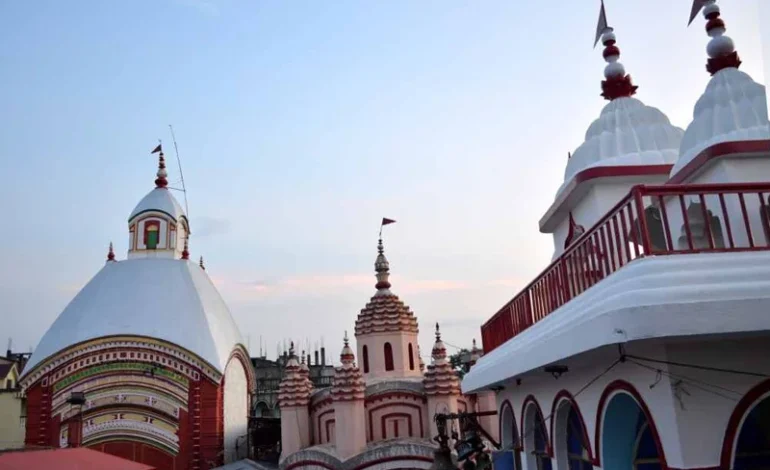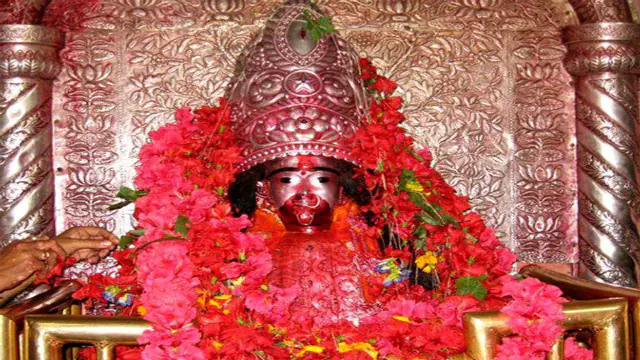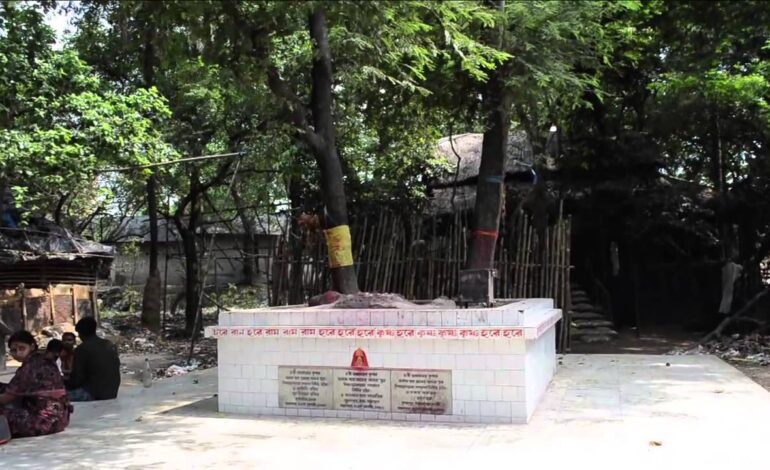
Tarapith Mandir : A Spiritual Destination
Tarapeeth, a quaint temple town near Rampurhat in West Bengal’s Birbhum district, is renowned for its temple dedicated to the Tantric goddess Tara and the adjacent crematorium. These sites hold deep spiritual significance for Hindus, serving as sacred pilgrimage destinations. The town’s name is closely linked to the traditional worship of the goddess Tara.
Tarapeeth is also celebrated for the legendary “mad monk” Bamakshepa, who devoted his life to the worship of Tara Devi. He performed rituals at the temple and practiced Tantric meditation with Kailaspati Baba in the crematorium. Bamakshepa’s ashram, located in the nearby village of Atla, continues to draw devotees and spiritual seekers.
Table of Contents
ToggleHistory Of Tarapith Mandir
Vasishtadev, the son of Brahma, assumed the form of Kama for spiritual practice. However, displeased with Kama’s indulgent behavior in his realm, he left Assam and journeyed to Radha Bengal to continue his ascetic pursuits. There, on the eastern bank of the Dwarka River in the Ishan region of Bakreshwar, within Radha, he performed deep penance on a Panchamundi seat established in the crematorium. Through intense meditation, he attained enlightenment and had a vision of the goddess Ugratar in her motherly form. Later, the saint Vamakshayapa also achieved enlightenment on the same sacred seat.

Structure of the temple
The north-facing Atchala temple, constructed with red bricks, features a robust foundation wall. The structure rises with multiple arched openings leading to the peak. Four smaller pinnacles adorn each corner above the main pinnacles. At the very top of the temple, a copper flag with a trident piercing through three lotuses stands prominently.
The entrance archway displays a depiction of Durga, while the left northern arch showcases carvings from the Mahabharata, including scenes like the Kurukshetra war, Bhishma’s demise, and Ashwatthama’s fall. On the eastern side of the northern wall, carvings illustrate scenes such as Sitaharan, Akalbodhan, and the battle between Rama and Ravana. The western side features intricate depictions of Krishnaleela. Within the sanctum sanctorum, measuring 12 feet by 6 feet, resides the idol of the goddess.
Description of the statue
One of Shiva’s divine pastimes is depicted through the image of the newborn. The original stone statue of Tara nursing the infant is housed within a three-foot-tall metal statue, which is the focus of most visitors. This metal idol represents Tara Devi in a fierce form, with four arms, a protruding tongue, and an intense expression. The goddess, adorned with golden hair, wears a silver crown on her head.
The statue is draped in a sari and decorated with garlands of marigold flowers, while a silver umbrella is positioned above its head. Vermilion is applied to the statue’s forehead, and priests also offer vermilion to visitors as a blessing. At the base of the idol, on the Golkar altar, rest two silver lotus feet. Devotees offer coconuts, bananas, or silk saris as part of their worship. The original statue of Tara Devi is renowned as a dramatic Hindu idol embodying the tender essence of Tara.


Worship method
The Tarapith temple resembles many other medium-sized temples found in rural Bengal. However, what sets it apart as a prominent pilgrimage site are the unique legends surrounding the temple, the rituals performed here—such as animal sacrifices—the devotional songs, the supposed mystical powers of the nearby water bodies and the rituals performed in the adjoining crematorium.
Devotees begin their visit by bathing in the sacred water body, Jeepati Kund, located near the temple, as it is believed to have healing powers. Only after this ritual do they enter the temple to offer their prayers. Daily animal sacrifices are a significant part of the temple’s rituals, where goats are sacrificed. Before the sacrifice, both the goat and the sacrificer bathe in the sacred waters to achieve purification. The sacrifice is performed with a single stroke of a sword, and the goat’s blood is collected as an offering to the goddess. Many devotees also apply a tilak of the sacrificial blood on their foreheads as a mark of devotion.
Each year, on the fourteenth day of the bright fortnight in Ashwin, the stone idol of Tara Devi is taken out of the temple and positioned on the Viram Mancha, facing west. On this special occasion, the goddess’s idol is bathed publicly, drawing large crowds of devotees.
Crematorium
The Tarapith crematorium is situated on the outskirts of the city, surrounded by dense forests along the riverbank, far from residential areas. This crematorium holds significant importance as a part of the Shakti Peeth. According to local beliefs, Tara Devi is said to appear in the darkness of the crematorium, drinking the blood of sacrificed goats.
For Tantra practitioners, the crematorium and its atmosphere are deeply associated with Tara Devi, as she is believed to have a special connection with such places. In artistic depictions, the goddess is often portrayed as residing in a crematorium. This connection makes the crematorium a preferred site for Tantra practices. Many ascetics permanently reside here, identifiable by their ash-covered bodies and long matted hair. These saints build makeshift huts under banyan trees, decorating the walls with vermilion-stained skulls and images of Hindu goddesses or revered saints of Tarapith, often adorned with garlands of gandharva flowers.
Tridents and garlanded skulls are placed near the entrances of these huts, symbolizing their practices. For Tantra rituals, skulls of humans, snakes, mongooses, jackals, and even Chandals, along with snake skins, are considered essential. The skulls of virgin girls or those who died by suicide are particularly revered for their supposed mystical powers. Such skulls are used in worship and rituals, including as vessels for drinking.

Saint Bamakshayapa
The most renowned sadhak of Tarapith was Bamakshayapa (1843-1911), whose ashram stood near the temple. A devoted follower of Taradevi, Bamakshayapa regularly worshipped at the temple and engaged in spiritual practices at the crematorium. He also practiced his sadhana in Maluti, a temple-filled village of the Malla kings, located near Tarapith in present-day Jharkhand. A contemporary of the famous Kali devotee Ramakrishna Paramahamsa, Bamakshayapa left home at a young age to begin his tantric sadhana under the guidance of Kailashpati Baba.
Over time, he became the central spiritual figure at Tarapith, with many devotees visiting him for blessings or healing. Some came simply to have darshan. Bamakshayapa, however, did not adhere to the temple’s rules. Once, he angered the priests by eating before the temple offerings were made. Legend has it that Taradevi appeared to the Queen of Natore in a dream, instructing her to feed Bamakshayapa first. From that moment, he was served before the goddess, and no one dared to stop him. It is also said that Taradevi, in a vision, appeared to Bamakshayapa in the form of a demon at the cremation ground and made him suckle.










